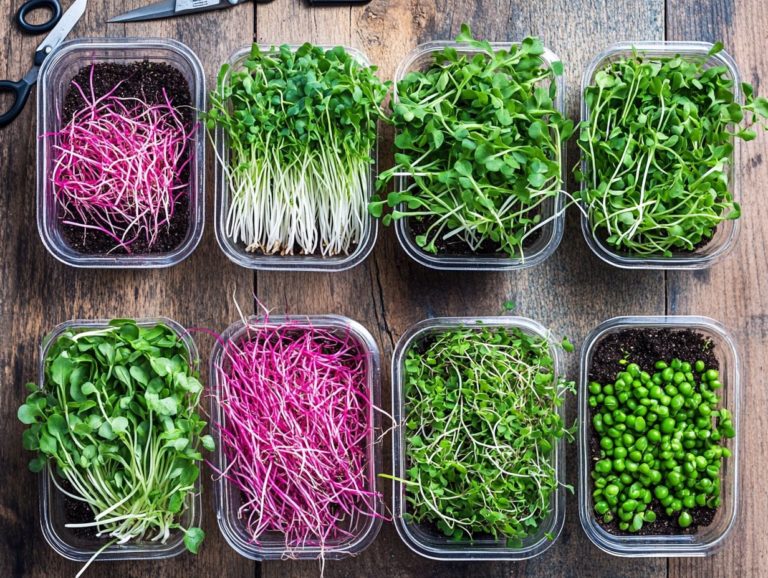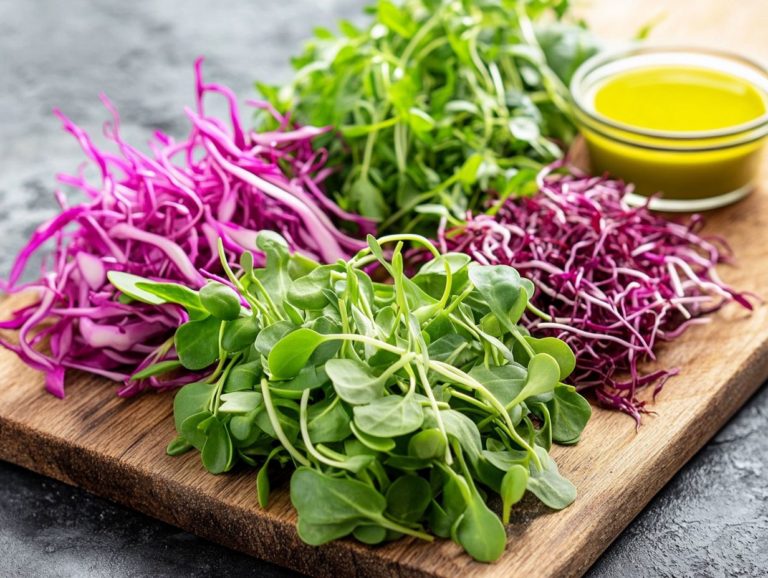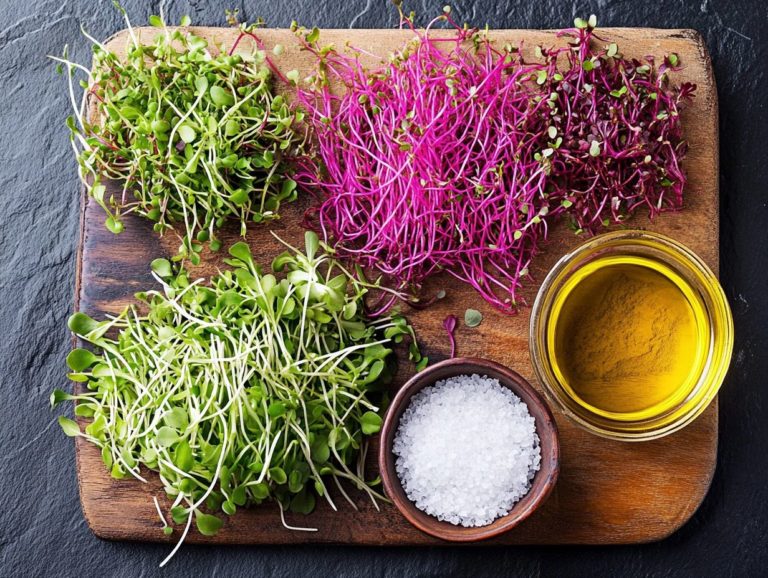How Microgreens Improve Cardiovascular Health
Microgreens are small but mighty plants, bursting with flavor and packed with nutrients. Their rising popularity stems not only from their delightful taste but also from a plethora of health benefits they offer.
In this article, you’ll explore how these vibrant greens can significantly enhance cardiovascular health. You’ll find essential nutrients and insights gathered from recent studies on how microgreens can combat chronic diseases. You ll also discover delicious recipes designed to seamlessly incorporate microgreens, including various leafy vegetables, into your meals.
You will also find handy tips for growing your own microgreens at home, along with important precautions to keep in mind for a successful harvest.
Discover how these tiny superfoods can transform your meals and boost your health!
Contents
- Key Takeaways:
- Microgreens and Cardiovascular Health
- How to Incorporate Microgreens into Your Diet
- Growing Your Own Microgreens
- Potential Risks and Precautions
- Frequently Asked Questions
- 1. How do microgreens improve cardiovascular health?
- 2. What nutrients in microgreens contribute to better cardiovascular health?
- 3. Can microgreens help lower cholesterol levels?
- 4. How often should I include microgreens in my diet for cardiovascular health?
- 5. Do different types of microgreens have different effects on cardiovascular health?
- 6. Are there any other benefits of consuming microgreens for cardiovascular health?
Key Takeaways:
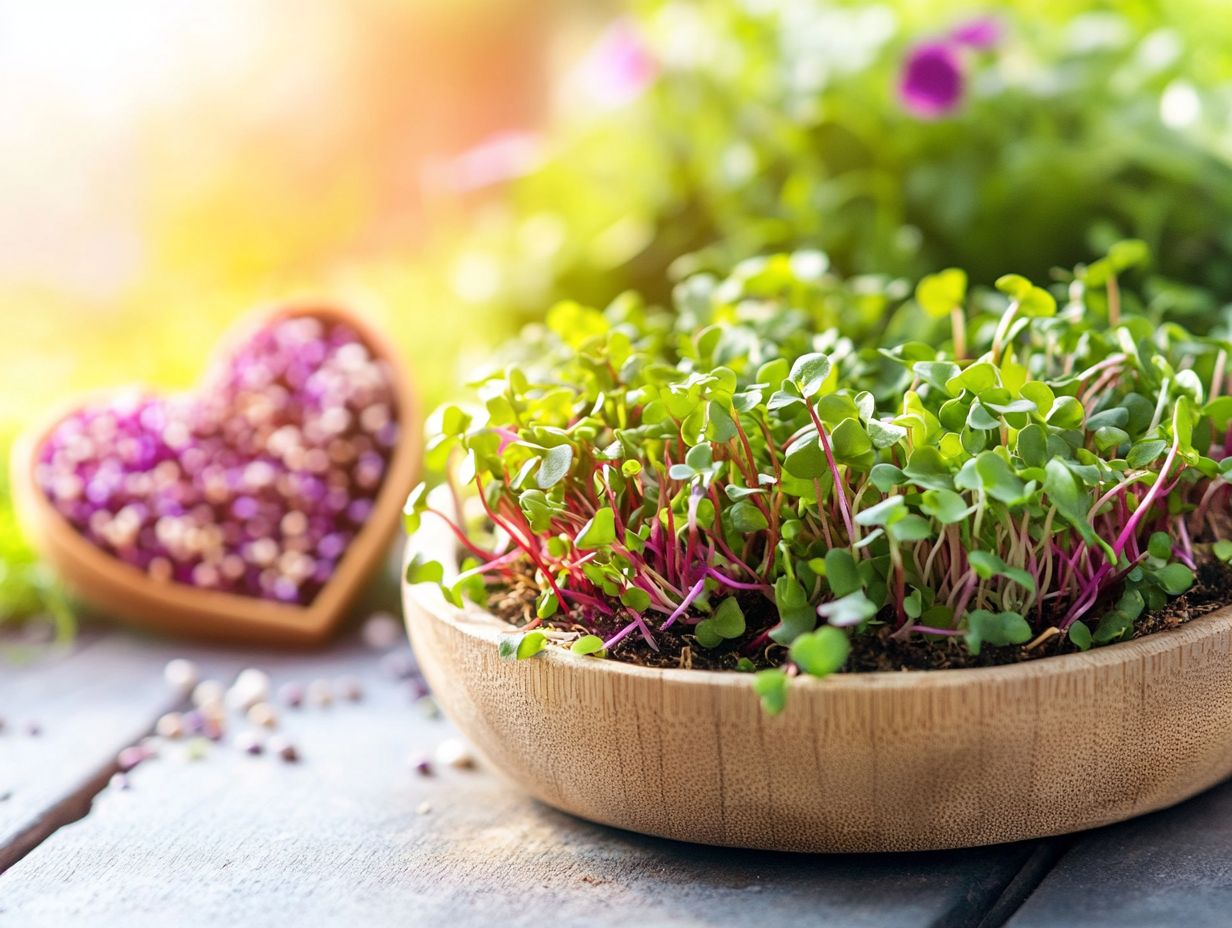
- Incorporating microgreens into your diet can provide key nutrients that improve cardiovascular health, such as vitamins, minerals, and antioxidants.
- Multiple studies have shown that consuming microgreens regularly can reduce the risk of developing cardiovascular diseases, including heart disease and stroke.
- Growing your own microgreens is a cost-effective and convenient way to ensure access to fresh and safe microgreens for improving cardiovascular health.
What are Microgreens?
Microgreens, often known as baby greens, are young seedlings that make a splash just after their first leaves unfurl. They are a vibrant and nutritious addition to your culinary repertoire.
Among the most popular varieties are red cabbage, broccoli, arugula, and Swiss chard. These are celebrated for their impressive health benefits and rich nutrient profiles. These petite plants deliver a significant punch, offering a concentrated source of vitamins, minerals, and antioxidants that can elevate any healthy diet.
The rising interest in microgreens, especially within the culinary sphere, underscores their versatility as a flavorful choice in salads, sandwiches, and gourmet creations.
These delicate greens not only brighten up your meals but also bring multiple health advantages to the table. For example, red cabbage microgreens are renowned for their remarkable vitamin K content and anti-inflammatory properties. Meanwhile, broccoli microgreens are packed with sulforaphane, a compound associated with cancer prevention. Moreover, incorporating these greens can enhance your health, as highlighted in our article on how microgreens support immune health.
As chefs increasingly weave these microgreens into their dishes, they uncover unique flavors ranging from peppery to subtly sweet that can elevate the taste profiles of appetizers and entrees alike.
Incorporating these nutrient-dense leafy wonders into your daily meals isn’t merely a culinary choice; it’s a proactive step towards enhancing your health and well-being.
Microgreens and Cardiovascular Health
Microgreens are essential for promoting cardiovascular health, thanks to their abundant antioxidants and plant compounds. These tiny powerhouses can help lower LDL cholesterol (the “bad” cholesterol) and reduce the risk of chronic diseases, including cardiovascular issues.
Incorporating a diet rich in microgreens can greatly enhance your heart health by providing essential dietary fiber, which aids digestion and helps regulate cholesterol levels. Research indicates that certain microgreens, like red cabbage and arugula, are particularly effective at countering the negative effects of a high-fat diet. For health enthusiasts, exploring the top microgreen varieties makes them a superb addition to any heart-healthy regimen.
Start adding these nutritious greens to your meals today for a healthier tomorrow!
Key Nutrients and Benefits
Microgreens are truly a powerhouse when it comes to nutrition, boasting high levels of vitamins, minerals, and natural compounds found in plants that provide health benefits. For example, red cabbage is packed with vitamin K, which is essential for blood clotting and maintaining strong bones.
The antioxidants in microgreens combat oxidative stress and inflammation. Incorporating microgreens into your diet adds significant fiber, which aids digestion and supports heart health, making them a crucial part of a balanced diet. For more on this, check out the health benefits of microgreens explained.
Within these petite greens lie other essential nutrients, including vitamins C and E, both crucial for boosting immune function and promoting healthy skin. This fiber content not only enhances digestive efficiency but also helps you feel full longer, which can be a game-changer for weight management.
The remarkable antioxidant levels, including carotenoids and flavonoids, play a vital role in protecting against chronic diseases by neutralizing harmful free radicals.
By including these vibrant greens in your meals, you can effortlessly elevate your nutrition while enjoying their unique textures and flavors. They add a delightful crunch and significantly enrich your daily dietary intake.
Studies and Evidence

Numerous studies, including those published in the Journal of Agricultural and Food Chemistry, reveal the amazing health benefits of microgreens, especially their role in lowering the risk of chronic diseases due to their high antioxidant content.
The evidence indicates that these tiny greens pack a concentrated punch of essential nutrients, such as vitamins C, E, and K, along with various bioactive compounds, which are substances in food that can affect your health. For instance, research shows that microgreens like mustard greens and radish sprouts are rich in glucosinolates, natural compounds that may help inhibit the growth of cancer cells. In fact, microgreens are superfoods you need to consider adding to your diet for their numerous health benefits.
A review in the International Journal of Food Sciences and Nutrition highlights that including a variety of microgreens in your salads, smoothies, and sandwiches can significantly boost your dietary quality. It’s a simple yet effective way to combat chronic inflammation and enhance your overall health by incorporating microgreen varieties and their health benefits.
How to Incorporate Microgreens into Your Diet
Incorporating microgreens into your diet is easy and immensely rewarding, as they enhance both the flavor and nutritional profile of your meals with their vibrant hues and crisp taste.
From salads to sandwiches, the culinary possibilities with microgreens are virtually limitless! You can easily add them to salads, sandwiches, and even cooked meals, offering versatile options for any health-conscious menu.
Imagine sprinkling them atop a savory omelet or blending them into a refreshing smoothie; microgreens like red cabbage or arugula infuse a delightful twist into traditional recipes, encouraging you to embrace the role of microgreens in healthy eating and a more nutrient-dense eating pattern.
Recipes and Meal Ideas
Get creative! Use microgreens to elevate your meals with delicious recipes. For instance, imagine a vibrant salad featuring red cabbage microgreens, mixed greens, and a tangy vinaigrette not only does it tantalize your taste buds, but it also delivers a significant nutritional punch.
You can add microgreens to wraps, soups, and smoothies, ensuring you savor the distinct flavors and health benefits these tiny greens offer.
Beyond salads, think about elevating your omelets by folding in a handful of arugula microgreens for that irresistible peppery kick. You could also blend them into your favorite smoothies for a subtle crunch and a luscious green hue. If you re a pasta lover, try garnishing your dishes with pea shoots; they add a refreshing pop and extra fiber.
These versatile greens can easily be incorporated into pesto or serve as a vibrant topping for grilled meats and fish, seamlessly integrating nutrition and flavor into a variety of culinary creations. Embracing microgreens in your daily meals can transform routine eating into a gourmet experience! Discover more about unlocking the antioxidant power of microgreens to enhance your dishes.
Growing Your Own Microgreens
Growing your own microgreens is not just easy; it s a fun adventure packed with flavor and nutrition! Cultivating these fresh, nutritious sprouts right from your kitchen allows you to enjoy unparalleled freshness. With just a handful of essential supplies and a bit of know-how, you can easily grow a variety of microgreens, such as red cabbage, broccoli, and Swiss chard. Don t miss out on these health benefits!
Whether you decide to plant your seeds in soil or opt for hydroponics growing plants in water without soil this process champions sustainability and elevates your meals with fresh tastes and added nutrition. It s a valuable enhancement to any health-conscious lifestyle.
Tips and Techniques
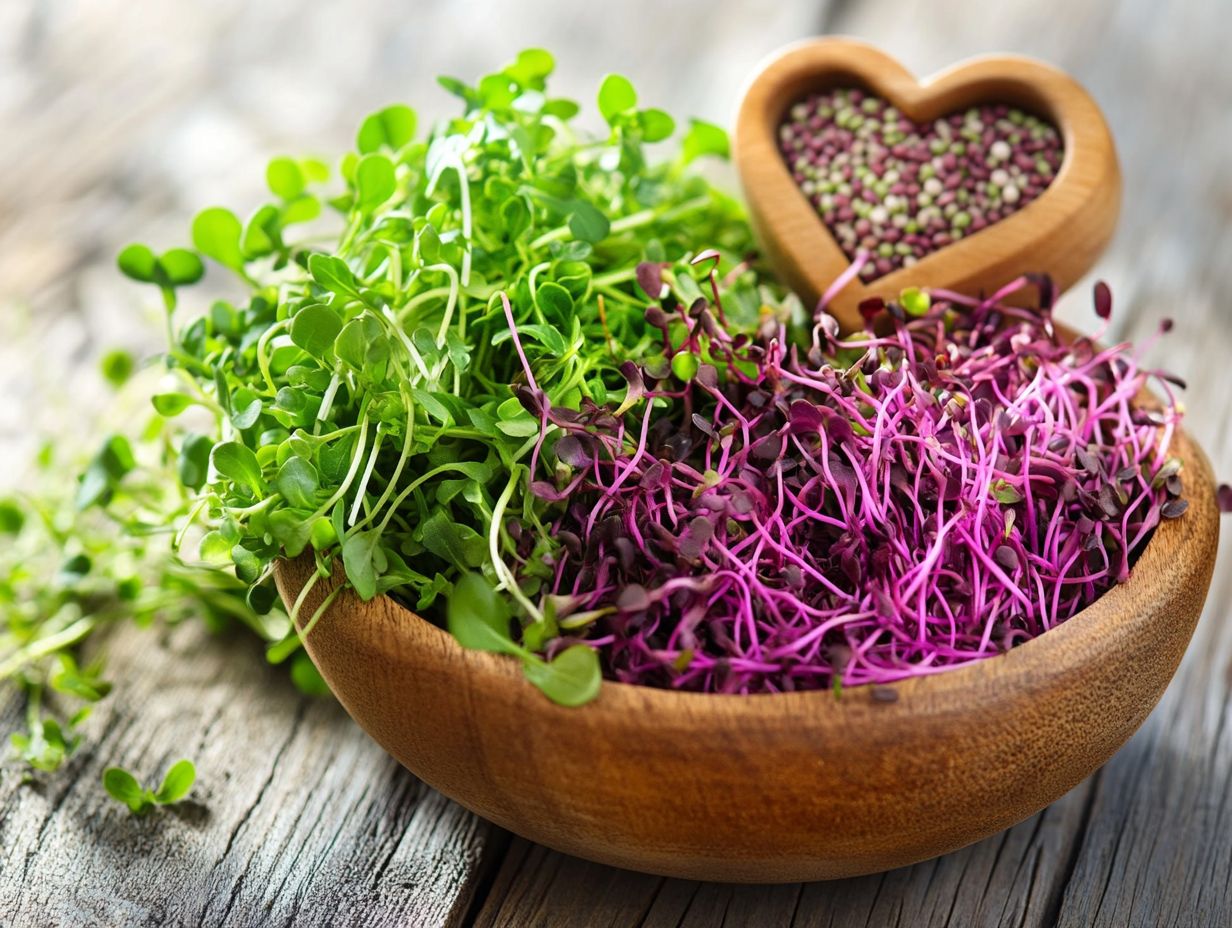
Several tips and techniques can significantly enhance your yield and the quality of your sprouts. Selecting the right seeds, like red cabbage or mustard, is essential. Providing adequate light, water, and airflow throughout the growing process is equally important.
Understanding the optimal harvesting times can maximize the nutritional punch of your microgreens, making it easier to incorporate them into various culinary applications. For optimal results, create the right growing environment by using a seed-starting mix that retains moisture without becoming overly soggy. Adequate drainage is vital to prevent mold and root rot.
Implementing a grow light can help mimic natural sunlight, especially during winter months when daylight is limited. This ensures your seedlings remain vibrant and healthy.
You can expect your microgreens to be ready for harvest in just 7 to 21 days, depending on the variety you choose. Use sharp scissors to snip above the soil line when harvesting. This keeps their structure and flavor intact, allowing you to enjoy these nutrient-packed greens at their finest.
Potential Risks and Precautions
While microgreens provide a wealth of health benefits, it s vital to recognize the potential risks and precautions linked to their consumption. This awareness will ensure that your eating experiences are both safe and enjoyable.
Allergies to certain microgreens can arise, especially in individuals who are sensitive to specific plants. Therefore, it’s wise to introduce these vibrant greens gradually into your diet. Be mindful of contamination issues that can stem from improper growing conditions or handling. This underscores the importance of adhering to best practices during both cultivation and preparation to safeguard your health while also considering the nutritional benefits of common microgreens.
Allergies and Contamination Concerns
Being aware of allergies and contamination concerns is crucial when enjoying microgreens. Certain varieties may trigger adverse reactions for some individuals. If you have known allergies to plants in the same family, or if you re trying microgreens like red cabbage or arugula for the first time, it s wise to consult with a healthcare provider.
To address contamination concerns, implementing proper sanitation practices during growth and harvesting is essential. This helps preserve the impressive health benefits of eating microgreens daily, which these nutritious sprouts offer. Certain microgreens can indeed trigger specific allergies, especially if you are sensitive to mustard or cabbage-family plants. Exercise caution as contaminants like E. coli, a harmful bacteria that can lead to foodborne illness, or Salmonella can thrive if hygiene is neglected. Thorough washing and proper storage are vital.
To enjoy microgreens safely, always rinse them well under running water, steer clear of pesticides, and opt for organic sources whenever possible. Additionally, maintaining clean growing equipment and using sterilized soil can minimize risks, ensuring that the vibrant flavors and nutrients shine without overshadowing health concerns. For those interested in the connection between microgreens and heart health, it’s essential to consider these practices.
Frequently Asked Questions
1. How do microgreens improve cardiovascular health?
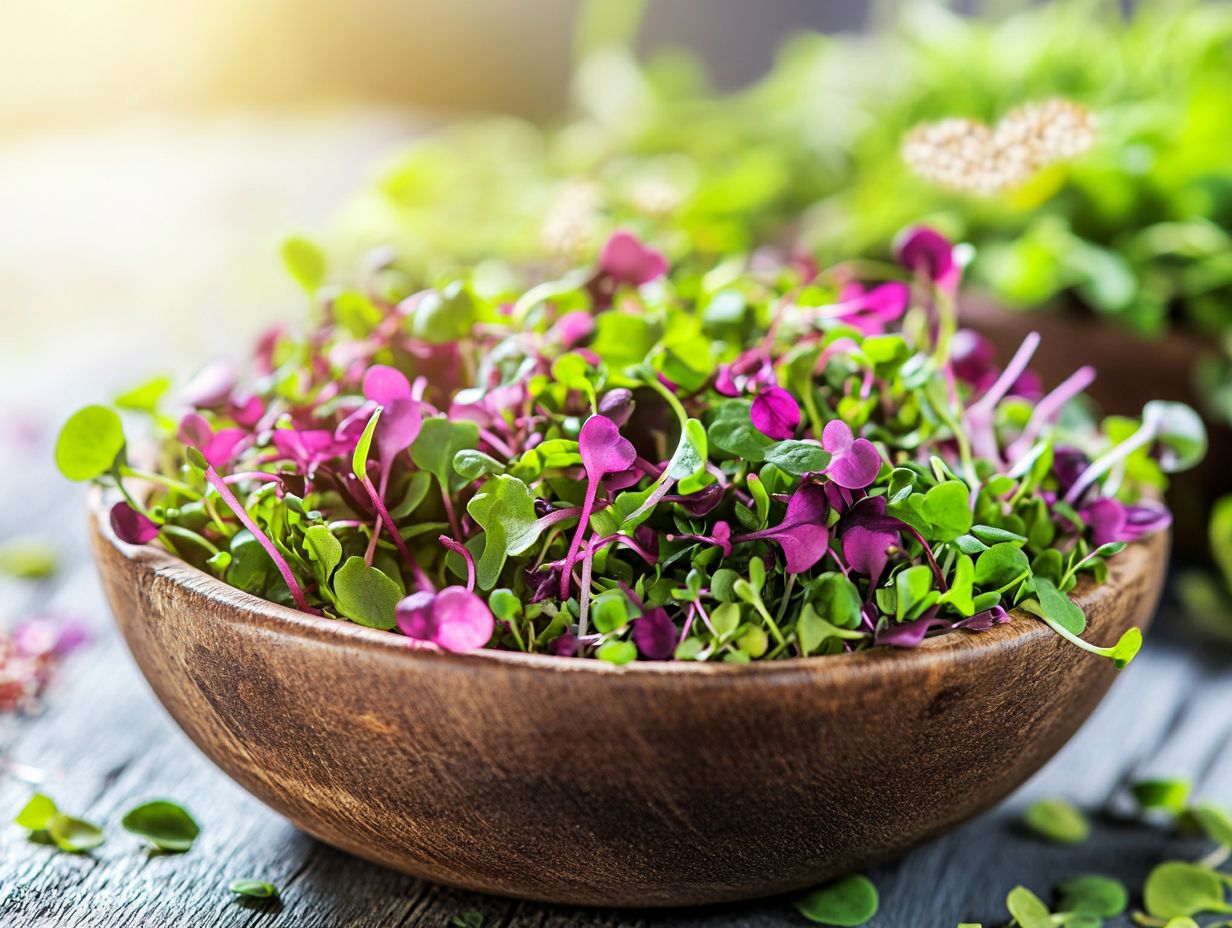
Microgreens are packed with essential vitamins and minerals. They include high levels of potassium, magnesium, and folate, which are known to improve heart health and reduce the risk of heart disease.
2. What nutrients in microgreens contribute to better cardiovascular health?
In addition to potassium, magnesium, and folate, microgreens contain high levels of vitamin C and vitamin K. Both are important for maintaining a healthy heart and blood vessels.
3. Can microgreens help lower cholesterol levels?
Yes! Microgreens help lower cholesterol levels due to their high levels of antioxidants and plant compounds. These compounds decrease “bad” cholesterol in the body, which can clog arteries and may increase your heart disease risk!
4. How often should I include microgreens in my diet for cardiovascular health?
Try to include microgreens in your meals 2-3 times a week for maximum heart health benefits! You can easily add them to salads, sandwiches, smoothies, or use them as a garnish.
5. Do different types of microgreens have different effects on cardiovascular health?
Yes, different types of microgreens may have varying levels of nutrients and antioxidants. For example, red cabbage microgreens have higher levels of heart-healthy polyphenols compared to other microgreens.
6. Are there any other benefits of consuming microgreens for cardiovascular health?
Microgreens have anti-inflammatory properties, which can reduce the risk of chronic diseases such as heart disease. Their high fiber content improves digestion and lowers the risk of obesity, a risk factor for heart disease.

